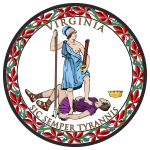| ||||||||||||||||||||||||||
| ||||||||||||||||||||||||||
 County Results
| ||||||||||||||||||||||||||
| ||||||||||||||||||||||||||
| Elections in Virginia |
|---|
 |
The 1896 United States presidential election in Virginia took place on November 3, 1896, as part of the 1896 United States presidential election. Voters chose 12 representatives, or electors to the Electoral College, who voted for president and vice president.
Following the state's delayed readmission to the Union, Virginia was unique among ex-Confederate states in not having a period of Republican control during Reconstruction, due to the failure of the Underwood Constitution to pass in 1868[1] and the consequent support for the Conservative Party that fused prewar Democrats and Whigs in the first postwar elections and consistently controlled the state legislature after readmission. From 1879, however, a fusion with the “Readjuster” faction of the state Democratic Party would revitalize the Republicans[1] until 1883, although the state GOP would remain competitive in statewide elections — only narrowly failing to carry the state in 1888[1] — until the Cleveland Administration eliminated federal oversight while the Walton Act created the secret ballot and began large-scale black disenfranchisement.[2]
However, despite its dominant position, the Democratic Party was deeply divided between the conservative Gold Democrats of a state whose economy was already substantially influenced by the rapidly industrializing Northeast, and a Populist-influenced faction centered in the state's rural areas.[2] Many Virginia farmers still depended upon a tobacco monoculture and had been affected severely by consistently declining prices, poor harvests[3] and the evolving rift between growing Northern and Southwest Virginia which were deeply tied culturally to the border states, and the declining, agrarian Southside.
After the nomination of Nebraska congressman William Jennings Bryan on a free silver platform was confirmed in June, it became clear he would face opposition in Virginia's larger cities and towns, with the leader of this opposition being the Richmond Times under Bryan's namesake Joseph.[3] At the beginning of the fall campaign Virginia was viewed as fairly secure for Bryan despite the defections that were expected to (and did) cost him the border states,[4] and this opinion did not change as the campaign developed during October.[5] Near the end, the state was heavily debated by politicians of opposing views on Bryan and Republican nominee, Ohio Governor William McKinley, some of whose supporters thought the GOP had a chance of carrying the state.[6]
Virginia ultimately voted comfortably for Bryan over McKinley. Bryan won the state by a margin of 6.56 percentage points; however, McKinley did make major gains in developing Southwest Virginia, where he was the first-ever Republican victor in Botetourt, Buchanan, Carroll, Grayson, Greene, Pulaski, Shenandoah, Smyth and Washington Counties.[7] Aided by the developing shift to a "lily-white" Jim Crow state Republican Party,[1][2] this region and these counties would become the party's stronghold in Virginia during the first half of the twentieth century, allowing the party to remain more viable than in any other ex-Confederate state other than North Carolina and Tennessee where extremely loyal Unionist Republicanism remained.[8]
Bryan would later win the state against McKinley again four years later and would later win the state again in 1908 against William Howard Taft.
- ^ a b c d Heersink, Boris; Jenkins, Jeffrey A. (March 19, 2020). Republican Party Politics and the American South, 1865–1968. Cambridge University Press. pp. 217–221. ISBN 978-1107158436.
- ^ a b c Moger, Allen. "The Rift in Virginia Democracy in 1896". The Journal of Southern History. 4 (3): 295–317. doi:10.2307/2191291. JSTOR 2191291.
- ^ a b Wright, James D. (May 18, 1978). "The farmer's revolt: the election of 1896 in Virginia". University of Richmond.
- ^ "A Conservative Estimate of the Electoral Vote Makes a Fine Showing for Bryan". The Hustler. Madisonville, Kentucky. September 22, 1896. p. 2.
- ^ "Chairman Jones' Bluff". Reading Times. Reading, Pennsylvania. October 14, 1896. p. 1.
- ^ "Doubtful States: Representatives of Them Interviewed on the Outlook — Opinions of the Common People: Results of Visits to Hotels and Railroad Stations — The Views Expressed". Evening Star. Washington, D.C. October 31, 1896. p. 10.
- ^ Menendez, Albert J. (2005). The Geography of Presidential Elections in the United States, 1868-2004. McFarland. pp. 322–324. ISBN 0786422173.
- ^ Phillips, Kevin P.; The Emerging Republican Majority, pp. 210, 242 ISBN 978-0-691-16324-6

